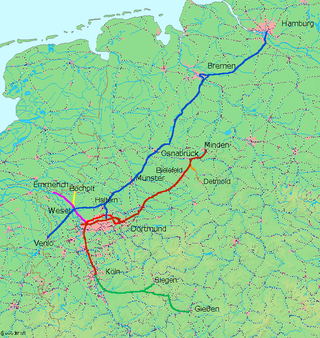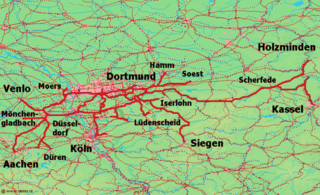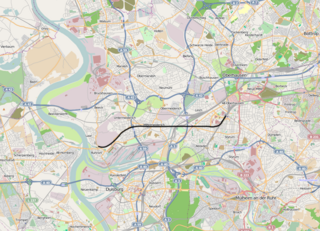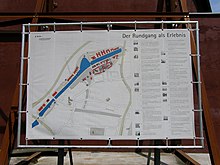
The Ruhr, also referred to as the Ruhr area, sometimes Ruhr district, Ruhr region, or Ruhr valley, is a polycentric urban area in North Rhine-Westphalia, Germany. With a population density of 1,160/km2 and a population of over 5 million (2017), it is the largest urban area in Germany and the third of the European Union. It consists of several large cities bordered by the rivers Ruhr to the south, Rhine to the west, and Lippe to the north. In the southwest it borders the Bergisches Land. It is considered part of the larger Rhine-Ruhr metropolitan region of more than 10 million people, which is the third largest in Western Europe, behind only London and Paris.

Duisburg is a city in the Ruhr metropolitan area of the western German state of North Rhine-Westphalia. Lying on the confluence of the Rhine and the Ruhr rivers in the center of the Rhine-Ruhr Region, Duisburg is the 5th largest city in North Rhine-Westphalia and the 15th-largest city in Germany.

The Rhine–Herne Canal is a 45.6-kilometre-long (28.3 mi) transportation canal in the Ruhr area of North Rhine-Westphalia, Germany, with five canal locks. The canal was built over a period of eight years and connects the harbour in Duisburg on the Rhine with the Dortmund-Ems Canal near Henrichenburg, following the valley of the Emscher. It was widened in the 1980s. The Rhein-Herne canal ship was designed specifically for this canal; normally of about 1300–1350 ton capacity, it has a maximum draft of 2.50 metres (8.2 ft), a length of approximately 80 metres (260 ft), and maximum beam of 9.50 metres (31.2 ft).
Duisburg Hauptbahnhof is a railway station in the city of Duisburg in western Germany. It is situated at the meeting point of many important national and international railway lines in the Northwestern Ruhr valley.

Oberhausen Hauptbahnhof is a railway station in Oberhausen, North Rhine-Westphalia, Germany. The station was opened in 1847 and is located on the Duisburg–Dortmund railway, Arnhem-Oberhausen railway, Oberhausen–Duisburg-Ruhrort railway and Oberhausen-Mülheim-Styrum railway and is served by ICE, IC, RE and RB services operated by Deutsche Bahn, Abellio Deutschland, NordWestBahn and Eurobahn.

The Industrial Heritage Trail links tourist attractions related to the industrial heritage in the Ruhr area in Germany. It is a part of the European Route of Industrial Heritage. The series of routes were developed between 1989 and 1999, however additions are still being made.

The 64 km long Cologne–Duisburg railway is one of the most important lines in Germany. It is the main axis for long distance and urban passenger rail services between Cologne and the Ruhr, served by Intercity Express, Intercity, Regional Express, regionalbahn and S-Bahn trains. It was the first section built of the Cologne-Minden trunk line and is one of the oldest railways in Germany. It was opened in 1845/46 and has been repeatedly modernized and expanded. Today the route comprises two or three double lines and is electrified throughout.

The Witten/Dortmund, Oberhausen/Duisburg railway is one of the most important railways in Germany. It is the main axis of long distance and regional rail transport on the east–west axis of the Ruhr and is served by Intercity-Express, InterCity, Regional-Express, Regionalbahn and S-Bahn trains.

Mülheim (Ruhr) Hauptbahnhof is a railway station for the city of Mülheim in the German state of North Rhine-Westphalia. It was renamed as a Hauptbahnhof in 1974 at the time of the rebuilding of the Dortmund–Duisburg line as part of the establishment of the Rhine-Ruhr S-Bahn. It is classified by Deutsche Bahn as a category 3 station.
Duisburg: Town and Harbour is the Theme Route No. 1 of the Industrial Heritage Trail, which passes through Duisburg, the Inner Harbour, Ruhrort, the Duisburg-Ruhrorter harbour and other attractions on the Rhine and Ruhr. These trails were first developed between 1989 and 1999.

Museum Küppersmühle (MKM) is a Centre for Modern and Contemporary Art based in Duisburg's Inner Harbour. It houses the Ströher Collection. It is part of the Duisburg: Town and Harbour section of the Ruhr Industrial Heritage Trail.
The actual boundaries of the Ruhr vary slightly depending on the source, but a good working definition is to define the Lippe and Ruhr as its northern and southern boundaries respectively, the Rhine as its western boundary, and the town of Hamm as the eastern limit.

The Oberhausen–Duisburg-Ruhrort railway is a line in the German state of North Rhine-Westphalia. It runs from Oberhausen via Duisburg-Meiderich to Duisburg-Ruhrort.

Essen West station is situated in Essen on the Witten/Dortmund–Oberhausen/Duisburg railway in the German state of North Rhine-Westphalia. It is served by lines S1, S3 and S9 of the Rhine-Ruhr S-Bahn.

Essen-Steele Ost station is located in the district of Essen-Steele in the German city of Essen in the German state of North Rhine-Westphalia. It is on the Witten/Dortmund–Oberhausen/Duisburg line and is classified by Deutsche Bahn as a category 4 station. It is served by Rhine-Ruhr S-Bahn lines S 1 and S 3.
The Mülheim-Heißen–Oberhausen-Osterfeld Nord railway is a line that formerly ran continuously in the western Ruhr region from Heißen to Osterfeld in the German state of North Rhine-Westphalia.
The Duisburg-Ruhrort–Dortmund railway was built by the Cologne-Minden Railway Company in the area to the north of its original Ruhr line to improve connections to mines and factories in the northern Ruhr region, which is now in the German state of North Rhine-Westphalia.

The Emschergenossenschaft is the oldest and biggest public German water board, („Wasserwirtschaftsverband”) located in Essen and responsible for the 865 km2 Emscher catchment with 2.2 million citizens. In Europe‘s largest urban area, between Dortmund and Duisburg as well as in the northern perimeter of the Lippe region, The Emschergenossenschaft offers modern, cost-effective water management that covers a broad range of responsibilities as sewage treatment, care and maintenance of waterways, natural remodelling of open waste water canals, flood protection, regulation of water flow and management of groundwater and rainwater
The Internationale Bauausstellung Emscher Park or International Architecture Exhibition Emscher Park was a programme for structural changes in the so-called German Ruhr region from 1989 to 1999 in order to show new concepts in terms of social, cultural and ecologic ideas.

Karl Ganser was a German geographer, urban planner, and former managing director of the International Architecture Exhibition Emscher Park.



























